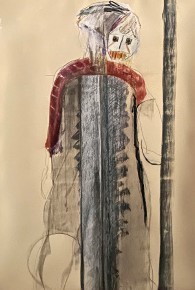 THE LABELS
THE LABELS

Aztec pulque deity Tepoztecatl with a large jar of it. Pulque contains the same esters as mezcal

Something interesting is happening to this pre-Columbian drinker of pulque

Lion-headed man of mammoth ivory, some 40,000 years old, from Stadel Cave, Baden-Württemberg, Germany
Both mezcal and the culture from which it comes manifest essential authenticity of being. I believe this harks back to, has its origins in, aspects of indigenous culture not far distant from the cultures that created the petroglyphs used on the labels. Mezcal is simply not like other distilled spirits, and I allude to this on the Los Nahuales labels.
Indigenous Pre-Hispanic humans, like all Neolithic cultures, saw themselves as part of the natural world, as other animals. I don’t mean that they thought about it. It was simply how things were. So it was entirely natural that a shaman could take on the form of another animal; a human had a human form, now he had a jaguar form. As a nahual, you were not turning yourself into something else, you were turning yourself into another version of yourself. You didn’t become a jaguar, you became your jaguar form. These cultures either were, or had been, hunter-gatherers: what kept them alive was going out and killing other animals, other creatures like themselves, which is why cave paintings and rock petroglyphs depicted hunting alongside say deities or shamans: it was all part of the mix. This is why hunters propitiated the animal they were going to kill, and afterwards treated its bones with care.
Wall petroglyphs, like Byzantine icons, had deep spiritual purposes and meaning, and had little other reason for existing. The images were apparently also seen as entryways into the world beyond daily reality.
Mezcal runs very deep. It is psychotropic, lending clarity of Mind and depth of understanding. Such attributes go back to the way we all were before we started separating ourselves from nature, before seeing ourselves as somehow different from animals, superior to the rest of creation. This separation is one of the tragedies of modern life. Mezcal cuts through it.
When you watch a great mezcal distiller, you see someone operating from something within, deeper than thought. He is tuned into the plant, its attributes, its nature, and he is operating within a way of being in the world that has very deep roots. Great mezcal is not just purified and concentrated agave esters: it embodies the way it was made and the nature of the person who distilled it.

COYOTE on NAHUAL is from Nine Mile canyon in Utah, dates from ca. 950-1250AD, and is part of a large petroglyph of Coyote creating the universe: he is surrounded by stars. He is not an animal the way we think of animal, but a personification of the creative force that, to the Fremont peoples, brought the planet and the stars, and of course human beings, into existence. This is not the creature we poison for killing sheep. Coyote is also the Oaxacan name of the agave Americana var. that has been successfully cultivated by Los Danzantes as part of a serious sustainability project (they have 900,000 plants in the ground); sustainable coyote is some 70% of what’s in the bottle.
JAGUAR is on the Reposado because Gustavo Muñoz, the man behind Alipus, has jaguar as his spirit animal. Jaguar has for millennia been a power symbol in indigenous spirituality. The image is from the astonishing Chiribiquete National Park in Colombia, site of some 75,000 cave paintings and petroglyphs, and known to its inhabitants as “Great Home of the Animals”. The images are dated from 20,000 BC continuously to the present: indigenous humans continue to create them. There are several images of human figures with a feline head.


BUHO for the Añejo is from Moon Flower Canyon near Moab, Utah, an area with many striking petroglyphs dating ftom as early as 5500 BC. I used the image because it is so powerful – whoever created it knew what an owl is – and because of the association of owls with age and wisdom. Its weathering means it is one of the earlier images. Thinking seriously about these images and what they stood for is a wise way to spend your time. Sip a good mezcal while you’re doing it.
The image on the Special Release is a funerary tribute to a lifelong friend, the artist Miklos Pogany. When he showed it to me perhaps 30 years ago, I asked him why he hadn’t published it. He said, I don’t want people to know that I have this inside me. Nearing death, he asked me which of his stuff I would like, I knew right away: this one. It hangs in my office at the head of the stairs, so you have to look at it.
Ansley Coale

